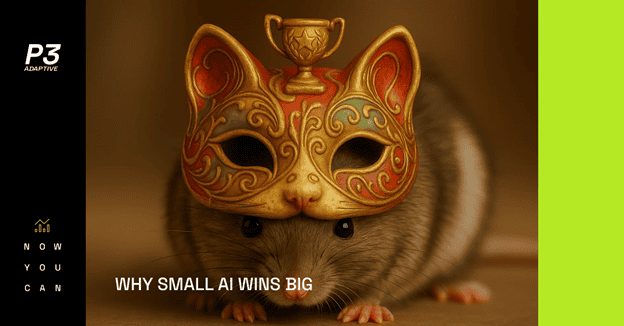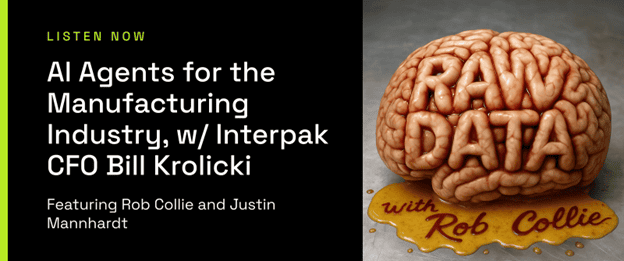
The Oracle Myth
Let me tell you about Bill.
Bill Krolicki runs operations for a manufacturing company. Smart guy. Experienced. Practical. When he started exploring AI, he had the same instinct a lot of leaders do: go big or go home.
Give AI access to everything—the PO database, vendor relationships, a decade of historical data. Train it on every exception and every edge case. Build the ultimate supply chain oracle.
You can guess what happened next.
It hallucinated. It contradicted itself. It gave confident answers that were confidently wrong. Like an intern who’d skimmed every manual but understood none of them.
The Everything-Bot Trap
Here’s the pattern I keep seeing: companies get excited about AI, and their brains instantly jump to the grandest possible vision.
“What if it knew our entire business?”
“What if it could answer any question?”
“What if we built the digital twin of our smartest employee?”
It’s seductive. I get it. If we’re going to invest in this technology, let’s swing for the fences, right?
Wrong.
That’s not innovation. That’s innovation theater.
The One-Thing Bot That Actually Ships
Bill did something different.
He shrank the problem.
He built Vendor Bot—a Power BI and Power Automate solution that reads supplier emails, spots late shipments, and updates the ERP before production grinds to a halt.
It doesn’t know everything. It just does one job perfectly. And that’s why it works.

Why Small Wins Big
The oracle myth kills more AI projects than bad technology ever could.
When you try to build the everything-bot, you create a system that:
- Takes forever to deploy
- Requires perfect data (which you don’t have)
- Demands everyone’s buy-in (which you’ll never get)
- Ships “eventually” (which means never)
When you build the one-thing bot, you:
- Ship this month
- Learn what actually matters
- Build credibility for the next one
- Get ROI while everyone else is still in meetings
Real innovation isn’t about building the everything-bot. It’s about making the one-thing bot that ships.
The Wrong Question vs. The Right One
Most companies ask: “What’s the biggest problem AI could solve?”
That’s the wrong question.
The right question is: “What’s the smallest valuable thing we could automate this month?”
Because you learn more from one working bot than from ten PowerPoint decks about the one you’re planning to build someday.
Bill learned that supplier emails follow predictable patterns. That some vendors are noise, others are signal. That he didn’t need full ERP integration to solve 80% of his delay issues.
He wouldn’t have learned any of that chasing the oracle.

Start With the Most Obvious Possible Win
Find the most boring, repetitive, groan-inducing task your team deals with. The one nobody wants but somebody always has to do.
That’s your first AI project.
Not because it’s glamorous. Because it’ll ship. Because it’ll work.
Bill’s vendor bot isn’t winning awards, but it saves ten hours a week and catches delivery issues before they become production crises. Real money. Real value. Real ROI.
And now he’s building the second bot. Then the third. Each small. Each focused. Each actually working.
While his competitors are still planning their oracle.
The Credibility Snowball (That Turns Into an Avalanche)
Here’s the thing nobody tells you about AI: technology isn’t the hard part.
Belief is.
Most teams have lived through the hype cycle too many times—big promises, small results. They’ve learned to nod politely and keep using Excel.
You know what changes that?
A bot that quietly works.
Not “in the demo.” In production. On Tuesday afternoon. When three suppliers send conflicting updates and someone needs to know if Line 4’s about to run out of parts.
That first working bot cracks open the skepticism. Then people start asking new questions:
“Could we do this for invoicing?”
“What about inventory forecasting?”
“Can it pull quality reports too?”
That’s how it grows.
Each small win connects to the next, expanding until you’re not running disconnected experiments anymore. You’re running a living system that learns, scales, and keeps paying dividends.
It starts as one bot. It ends as a self-feeding ecosystem of automation and intelligence.
How P3 Adaptive Helps
We don’t build one-off bots. We build momentum.
P3 helps companies find the first win—the one that ships fast, proves value, and earns internal trust.
Then we help you scale it: connecting workflows, automating the next process, layering in analytics, and expanding until the entire system starts working smarter together.
Think of it as rolling a snowball downhill. We help you pack it tight at the top. After that, gravity—and results—take over.
Most firms hand you an “AI strategy” deck.
We hand you your first working bot and the blueprint to grow it.
Because once the small win proves what’s possible, scaling stops being risky. It becomes obvious.
So here’s the question: what’s the smallest, most valuable AI win hiding in your business right now?
Not the biggest idea, the one that gets traction fast.
Because once you see it working, you won’t stop there. You’ll keep building, connecting, automating—until your “small” AI win quietly turns into a competitive advantage.
Forget the oracle. Build the bot that ships, and the system that grows.
Want help building that first win and everything that follows?
Start your AI snowball with P3 Adaptive
Get in touch with a P3 team member